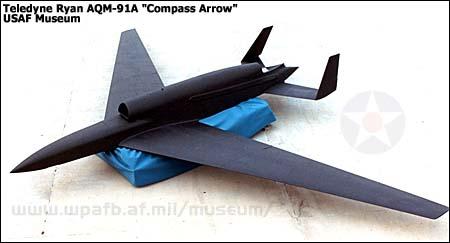Teledyne Ryan AQM-91 Firefly
In the mid-1960s, the U.S. Air Force had a requirement for a long-range high-altitude photo-reconnaissance RPV to overfly the People's Republic of China. In 1966, Teledyne Ryan was awarded a contract to develop its Model 154 Firefly drone for this purpose under the Compass Arrow program. The Model 154 first flew in June 1968, and basic flight testing and evaluation continued through 1970. In that year, the official designation AQM-91A was allocated to the Firefly.
The AQM-91A was a subsonic high-altitude aircraft powered by a single General Electric J97 turbojet. After launch from a DC-130E aircraft (which could carry two AQM-91As), the Firefly could reach an altitude of 23700 m (78000 ft). It had a powered range of more than 3700 km (2000 nm) plus about 160 km (100 miles) more of glide flight. For recovery, the Firefly deployed a parachute and was then snatched in mid-air by a helicopter equipped with a Mid-Air Retrieval System (MARS). The AQM-91A was controlled by a Doppler/Inertial navigation system which achieved an accuracy of about 0.5% of the distance flown. A microwave command guidance system was used for control in the terminal phase of the flight. Primary mission equipment was an Itek KA-80A panoramic camera, but the Firefly could also be equipped with IR sensors or ELINT (Electronic Intelligence) equipment.
 |
| Photo: U.S. Air Force Museum |
| AQM-91A |
The AQM-91A was one of the first aircraft designed specifically for low observables. The flat bottom, rounded fuselage, and inward-canted fins reduced radar cross section, and the top-mounted engine minimized the IR signature. Non-metal construction elements and RAM (Radar Absorbing Material) covering of critical areas were also used to further reduce radar reflectivity.
During the flight tests, the Firefly met with all kinds of problems, one of which even led to a premature flight termination and unintentional landing in a non-secure location. This event in August 1969 was actually the first revelation of the existence of the then highly secret aircraft. More than 20 AQM-91As were built by Teledyne Ryan, and after a successful operational test and evaluation program in late 1971, the Firefly RPVs were ready for deployment. However, the changing political situation at that time prevented the originally intended use over China. Because there were no other missions forthcoming, the AQM-91A vehicles were placed in permanent storage in July 1973, only to be scrapped a few years later.
Specifications
Note: Data given by several sources show slight variations. Figures given below may therefore be inaccurate!
Data for AQM-91A:
| Length | 10.4 m (34 ft) |
| Wingspan | 14.6 m (48 ft) |
| Diameter | 97 cm (3 ft 2.4 in) |
| Weight | 2375 kg (5245 lb) |
| Speed | Mach 0.8 |
| Ceiling | 23700 m (78000 ft) |
| Range | > 3700 km (2000 nm) |
| Endurance | 4.5 hours |
| Propulsion | General Electric J97-GE-100 turbojet; 23.4 kN (5270 lb) |
Main Sources
[1] William Wagner, William P. Sloan: "Fireflies and other UAVs", Midland Publishing, 1992
[2] Kenneth Munson: "World Unmanned Aircraft", Jane's, 1988
Back to Current Designations Of U.S. Unmanned Military Aerospace Vehicles
Back to Directory of U.S. Military Rockets and Missiles
Last Updated: 11 October 2002